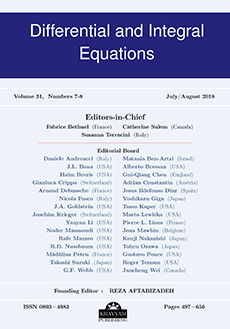Abstract
By capillary fluids we mean compressible, inviscid fluids whose energy depends not only on their density but also on their density gradient. Their motion is thus governed by systems of conservation laws, either in Eulerian coordinates or in Lagrangian coordinates, that are a higher-order modification of the usual equations of gas dynamics. In both settings, we receive models that also arise in other fields, in particular in water-waves theory and quantum hydrodynamics. Those Hamiltonian systems typically admit three types of planar traveling waves, namely, heteroclinic, homoclinic, and periodic ones. The purpose here is to review the main tools and results regarding the stability of those waves, under most general assumptions on the energy law. Special attention is devoted to the correspondence between traveling waves in Eulerian coordinates and those in Lagrangian coordinates.
Citation
Sylvie Benzoni-Gavage. "Planar traveling waves in capillary fluids." Differential Integral Equations 26 (3/4) 439 - 485, March/April 2013. https://doi.org/10.57262/die/1360092830
Information





